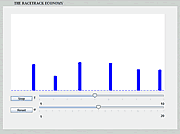Spatial Economics
As globalization continues to surge onward in a variety of fields, it has become increasingly difficult to analyze economic activity in developing countries based solely on a "country" framework. Instead, discussion of interregional economic disparity within developing countries must address the smaller "cities" and "communities" that make up those countries, while analysis of development in regions spanning multiple nations and economic acceleration in border zones must take the larger community into context.
The 1990s saw the beginning of rapid development in the field of spatial economics (also called new economic geography), a theoretical construct used to analyze the geographical distribution of economic activities that has garnered attention as a new frontier in the study of economics. This new field focuses on the geographical dimension of economic activity, an area that standard economics has not always treated effectively. In spatial economics, the interaction between "agglomeration force," which draws economic activity to a specific region, and "dispersion force," which disperses economic activity throughout the surrounding area, determines the geographical distribution of economic activity.
Major models of spatial economics incorporate the elements of transportation cost, economy of scale, and love of variety into standard microeconomics. These models first assume that a certain amount of transportation cost is incurred when goods produced at one location are consumed at another. Next, the models hypothesize an economy of scale, in which production cost per unit decreases as production volume increases. The final hypothesis is love of variety – the idea that, when buying 200 yen worth of snacks for a field trip, for instance, it would be more satisfactory to buy several different kinds of snacks that total 200 yen than to buy 20 pieces of the same 10 yen candy.
Paul Krugman, the 2008 winner of the Nobel Prize in Economics, conducted a simulation using a spatial economics model called the "Racetrack Economy" model (Krugman). This model hypothesizes several cities (in Krugman's case, 12 cities) arranged at equal intervals in a circular fashion, like the numbers on a clock face. The economy includes farmers, who live in the cities and do not move, and factory workers, who move between the cities in search of higher wages and lower prices. Initially, the populations of the cities are only slightly different (a uniformly equal city size causes equilibrium, which prevents the simulation from working). Using these basic conditions, Krugman modified transportation cost (T) and the degree of love of variety for industrial products (σ) in order to analyze changes in the numbers and locations of agglomerations.
The following is a recreation of the Krugman simulation with the number of cities increased to 50. The x-axis corresponds to cities 1 through 50. As Krugman's simulation is configured circumferentially, the cities on the far left and right should be considered to be connected. The y-axis shows the industrial production share of each city in the simulation world. A city with a high y-axis value has "agglomeration" of industrial production.
In this simulation program, variables "T" and "σ" can be changed. The simulation operates as follows.
- The "T" slider changes transportation cost. A value of 1 represents no transportation cost, while a value of 10 represents significant transportation cost.
- The "σ" slider adjusts the degree of love of variety for industrial products. A value of 1 represents a strong love of variety, while a value of 20 represents a limited love of variety.
- The "Start/Stop" button starts and stops the simulation.
- The "Reset" button resets the simulation.
The Racetrack Economy
Variables "T" and "σ" can also be changed while the simulation is in progress. This allows the observation of agglomeration formation, agglomeration dispersal, and changes in the numbers and locations of agglomerations according to various parameters.
References
Krugman, P. (1993) On the number and location of cities. European Economic Review, Vol. 37 (2-3), pp. 293-298.


